Immersed in the Holy Land: Six days of discovering Israel
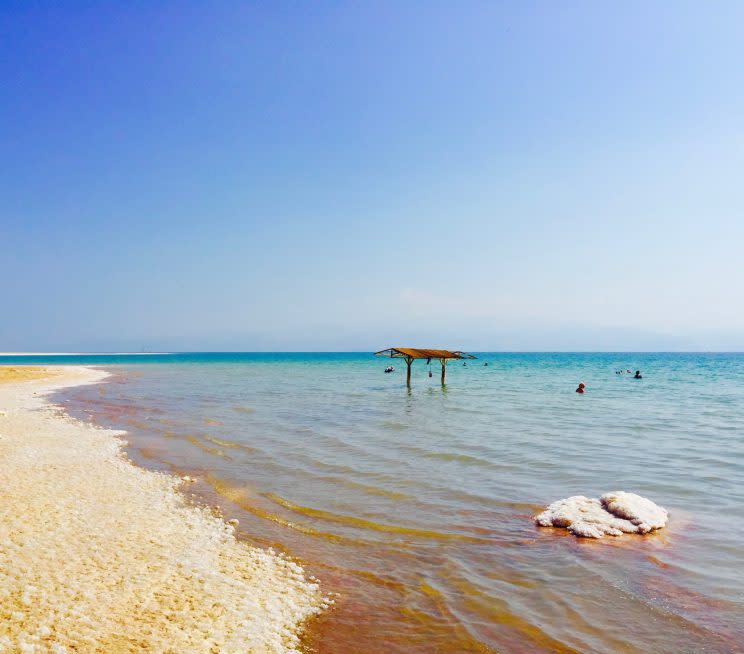
I’m on the shores the Dead Sea, about to make a big mistake. It’s midday and the sun is bearing down. It’s Middle Eastern and broiling, propelling me off the beach and under the waves as fast as possible. The surface glistens. This may be the most famous body water in the world. It’s certainly the most unique, made of a liquid like no other, and lying at the lowest point on the earth.
Yet what isn’t known, and can’t be known until you’re here, is what it’s like to actually step into the Dead Sea, how intensely salty and surreal the sensation. I expected buoyancy, but floating here isn’t so much like bathing in a warm lake. It’s like resting on top of an overheated waterbed. It’s so thick, there’s people actually bobbing past on plastic chairs.
The water may look inviting, however it’s not sandy underfoot, it’s calcified, razor-sharp salt. Every step is a sharp reminder why everyone else had the good sense to wear sandals. And if missing that memo was a mistake, trying to salvage things by rushing in, instead of slowly and carefully lying backwards, was an even bigger blunder. I took three, toe-slicing steps and dove headfirst, only to submerge with the sea’s salt-filled water streaming into my eyes, blurring my contacts and all but blinding me. Then I had to somehow find my way back to the beach by without swimming or stepping on anything, including the shore.
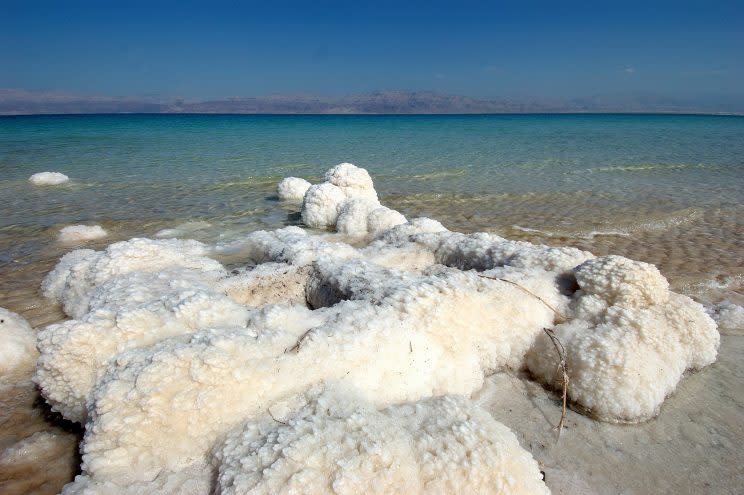
And yet what a wondrous experience is this sea. It’s warmer, weirder and more out of this world than seemingly possible. In a sense, that’s the story of Israel. It’s more exotic and intense, more alluring and magical than ever imagined. That’s saying something in a country with a capital city that stirs such passions that there is a feverish, rapturous syndrome now named for it. And it’s not only Jerusalem that captures the soul. There is so much history here, so much fervor in such a small space. Every inch of the land is either deeply coveted or fiercely claimed. This has held true for millennia, and the adherence seems only to be growing deeper.
I’m here for less than a week, a woefully short time given how much there is to see and do. But no matter how small the country, no single visit could ever do it justice and mine will not be the exception. Almost all of my days will be spent in the upper half of the country (the quick trip south to the Dead Sea being the sole detour.)
My traveling companion is Younis Abdullah, a 69-year-old Bedouin guide from the Negev desert, who grew up a shepherd before landing in the hotel industry and rising through ranks of the Hilton chain. (An early claim to fame involved serving Elizabeth Taylor breakfast in bed, an experience he was prepared to recall, though not repeat). Today he earns his living escorting tourists. When he retires, whenever that might be, he yearns to return to his sheep in the desert.
Abdullah tells me he knows “every stone on Masada” by which he means he’s seen every inch of the country, from the Syrian border on the northern edges of Golan to the Sinai in the very south. He also knows about traveling light. In the week we’re together, I never see him with a knapsack, much less a change of clothes. One shirt, orange, one pair of khakis, every day. When he sleeps, Abdullah says he prefers the floor.
As we travel, he shifts seamlessly between Hebrew, Arabic and English, the language switching on the subtlest of clues. (To a local, distinguishing between a Jew, a Palestinian, an Israeli Arab, a Christian Druze and a Russian émigré is surely bred in the bone, though to an outsider the differences blessedly blur.)
Our trip to the Dead Sea begins in Jerusalem and takes us east on an ultra-modern, lightly trafficked highway, to the borders of the West Bank. As we approach, I’m expecting razor wire, cement barricades, shelled buildings. Instead there are brightly lit gas stations and strip malls. We breeze through a wide open checkpoint. A few bored-looking soldiers wave us through as we cross into the occupied territory. It soon becomes clear, of course, that entering the West Bank isn’t the issue. Anyone’s free to do that. It’s the traffic coming the other way, into Israel proper, that’s tightly controlled. Palestinians must have a special worker’s permit to get in, and foreigners are usually required to show their passport.
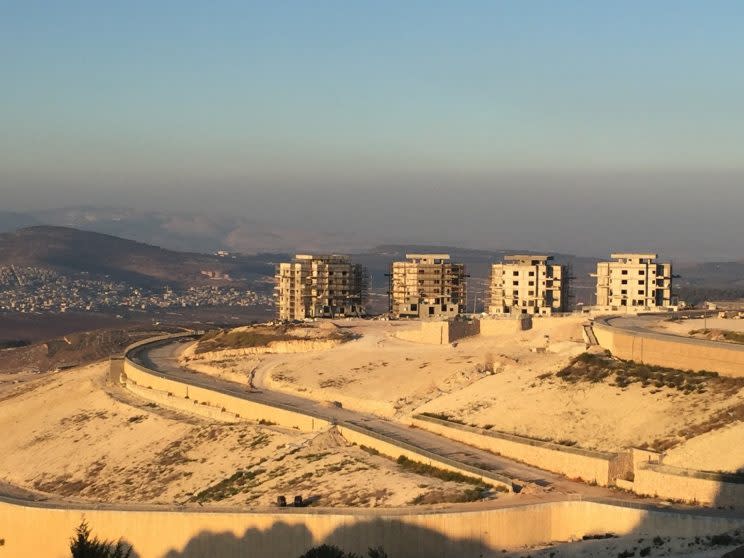
On the hilltops overlooking the highway, are mile after mile of white multi-story apartments. They look like little Lego neighbourhoods, speedily assembled and snapped into place. A cookie-cutter sprawl, with each community fenced in and defended by guard towers and a gated entrance. These are the disputed new settlements that stretch out now in increasingly broad swathes. They’re the new suburbs of Jerusalem, filled with residents solidifying their hold on Judea (the biblical term for West Bank) or seeking cheaper housing.
It’s evening now, and as we drive further into the night, Abdullah points to the Judean Desert, on our right, where scatterings of tiny Bedouin encampments sparkle in the hilly darkness. Just ahead, and much brighter, are the lights of Jericho, a Palestinian community and one of the oldest cities in the world, dating back 9,600 years before the birth of Christ. With beautifully warm desert winds blowing through our windows and a full moon rising overhead, it’s impossible not to be entranced by the aura of it all.
As I soak in this moment, Amman, the capital of Jordan appears in the far distance, atop the Abarim range. I barely glimpse it before we are headed down, down, down, past a sign marking sea level, and then a drop another 440 metres, sidewinding down this ancient route: the impenetrable darkness of the Judean sands on our right and the moon reflecting off of the Dead Sea to the left.

It seems almost to stagger belief to see the skylines of Jerusalem, Jericho and Amman within a night’s drive, and to know that Masada, Herod’s mountaintop fortress erected in 100 BCE, stands just ahead. So many legendary places in such close proximity, so many entanglements and interpretations.
Trying to unspool the history here is a pointless, and worse, deeply divisive task. The country’s jumbled threads twist back to the dawn of civilization. How far do you go back, to the Jesubites, the first settlers of Jerusalem, 3,400 years ago? Do you start at Year 0, with the birth of Christ? Or keep things contemporary, going no further than 1917 when a homeland for the Jewish people received first blessing? If so, others will point to 1948, when Israel declared independence (and the surrounding Arab nations attacked). Or 1967, when the fledgling state struck back, seizing East Jerusalem, the Gaza Strip, the West Bank, the Golan Heights and the Sinai Peninsula during the Six-Day War.
Regardless, each starting point has its own adherents and to be here is to wrestle with all of it, or at least, be reminded frequently. Being impervious isn’t an option, not when the evidence of overlapping histories, the claims and counterclaims, infuses everything. It shapes the country, explains the culture, and indeed makes the place so intriguing.
And the epicenter of all, as always, is Jerusalem.
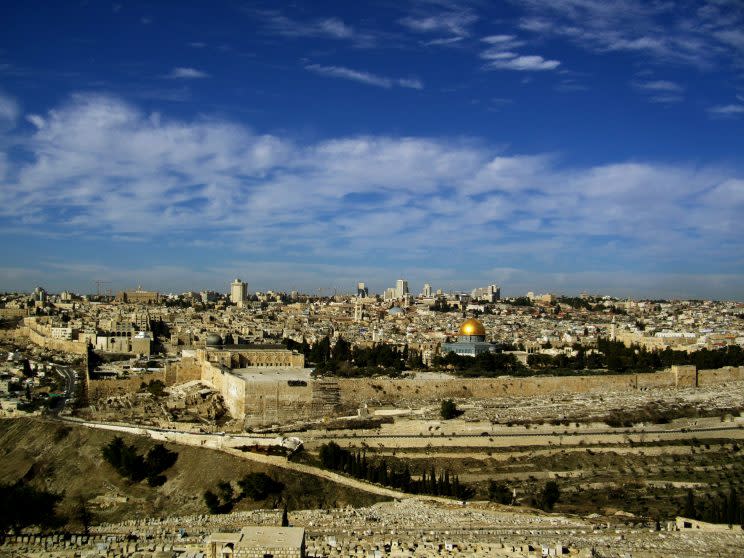
When we arrive we drive to the peak of Mount Scopus, passing through The Hebrew University of Jerusalem, to a point near the campus providing a spectacular view of the capital. Directly ahead of ahead of is the Dome of the Rock, its golden roof shimmering above the Old City. Below us, the Mount of Olives and the Garden of Gethsemane, where Jesus is said to have frequently prayed, and where he spent his last night, before his arrest and crucifixion. Here as well is the Basilica of Agony, built around the rock Jesus is believed to have wept over. Immediately adjacent is the tomb of the virgin Mary.
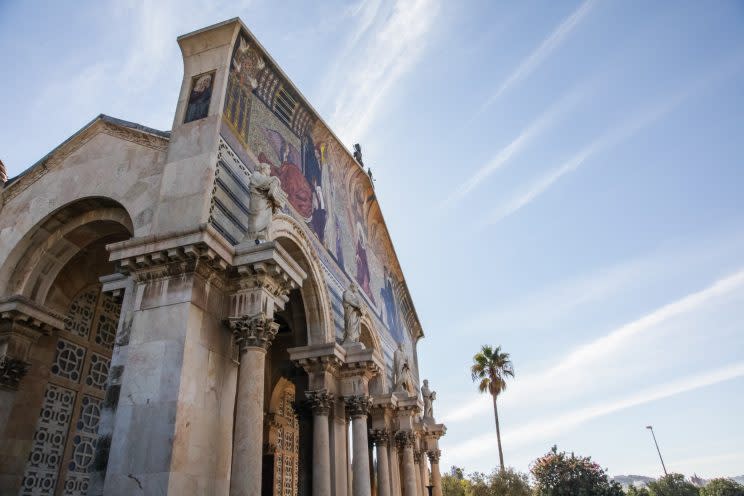
It’s from these grounds that Jesus ascended to heaven, according to his Apostles. This is also the place where many Jews believe the resurrection of the dead will commence as soon as the Messiah returns.
Given the site’s significance you might expect a cornucopia of kitsch with vast parking areas for tour buses. To its credit though, it could hardly be less adorned. If you didn’t know its history, Gethsemane would seem an entirely undistinguished patch of turf, with a few olive trees and the standard assortment of shrines and temples. (For shameless tchotchkes you have to go to the place of Jesus’ baptism in either Qasr al-Yehud or Tiberias, sites with so much tourism potential that a duplicate version was created in the north.)
Infinitely more imposing than Gethsemane is the eastern edges of the Old City, across the road. The walls alone warranted UNESCO heritage status. Forty-feet up, eight-feet across of solid limestone, they are austere and unfathomably impressive. Standing in their shadows, especially at night when the walls are bathed in light, is to understand immediately why Jerusalem holds such sacred and symbolic meaning for so many millions.
Entering, we go through the Jaffa Gate, one of the seven entrances to the Old City, and step into the Christian Quarter, a preserve of Franciscan monasteries, Greek Orthodox temples and the Church of the Holy Sepulchre. (More on that in a moment). We’re heading to the Western Wall in the opposite corner. The 20-minute walk will take us along covered, cobblestone streets through the maze that is the Armenian section before bringing us to the Jewish Quarter. My guidebook warns against navigating these laneways at night, advising that the hidden alleys and darkened nooks are a haven for muggers and thieves.
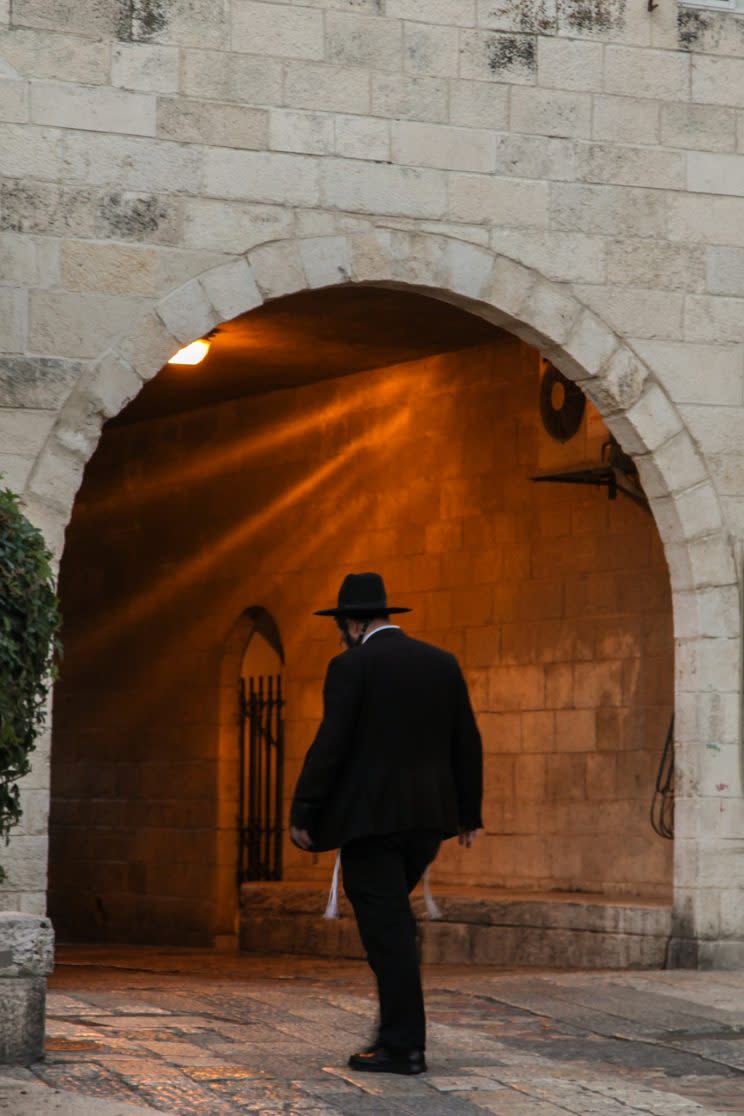
Maybe that was the case when the book was written, 11 years ago, but tonight the walk could hardly feel safer. Though narrow and enclosed, the streets are abundantly lit and well traveled. Every so often a pair of soldiers, many of them women, wander past, more in a heading-home sort of way, rather than actually on patrol. Still, the machine guns slung casually over their shoulders are an oddly reassuring sight.
After a flurry of twists and turns, the passage we’re taking opens up to an enormous plaza that angles down and then flattens out into a piazza framed by a 19-metre mass of limestone. Floodlights bathe the scene in a brilliant ochre glow. We’re at the Western Wall, the holiest of holy places where Jews are allowed to pray. Hundreds of ultra-orthodox Haredim rock back and forth towards the wall in an emotional, rapturous display, while others stick notes into crevices between the stones. Soldiers mill about, praying or simply watching the crowd.
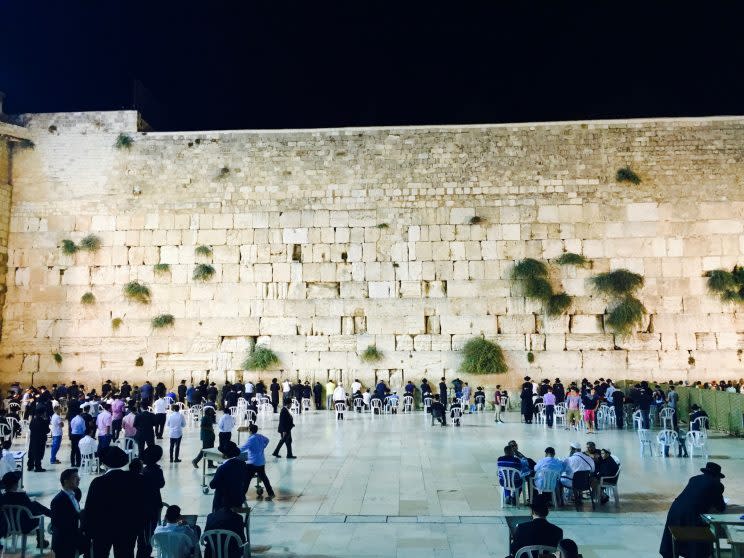
And is so often the case here, the reality is even more spectacular than imagined. Maybe it’s that the wall is bigger, the lights brighter, the faithful more fervent than expected. Whatever it is, I can see how ‘Jerusalem Fever’ – that syndrome of sudden delusions and psychotic episodes – takes hold for so many visitors to the city. In my case though, I just want to sit quietly and soak up the scene all night.
(Not to detract from the setting, but it probably should be said that this isn’t actually the holiest site in Judaism. That would be a few, inaccessible feet away. When Herod built the Second Temple here, he needed a level surface. As Jerusalem is anything but flat, he had to build a mount on which the temple could sit. The Western Wall is all that remains of that mount. ‘Peak’ holiest is just inside, where the temple once stood. However, that’s where the Dome of the Rock now sits, marking the spot where the Prophet Muhammad ascended to heaven, according to Islamic belief.)

You begin to get a sense of the inconvenient intimacy that is Israel.
If that cluster of sacredness wasn’t cozy enough, less than a 10-minutes walk away is the holiest site in Christendom, the Church of the Holy Sepulchre, where Jesus was crucified, and is believed to have been buried. Of the nine Stations of the Cross that make up the famed Via Dolorosa (Jesus’s final steps or ‘Way of Suffering’) through the streets of the Old City, the last four occurred within these walls.
As hallowed as the church is, it’s surprisingly ramshackle and frankly, bewildering. Its byzantine layout makes no sense at all until you learn that the building is collectively managed by the Greek Orthodox, Armenian Orthodox, Egyptian Copts, Ethiopian Orthodox and the Catholic Church. Each institution has its own take on Christ’s journey, and its own shrine paying homage to the key moments. The result is a perpetual sense of déjà vu as you wander the halls.

Still, I emerge deeply taken by the devotion shown by so many here. Being able to place their hands on the most sacred spots in their saviour’s life triggers overwhelming emotions. This is particularly true of the Stone of Anointing, where Jesus was laid after being removed from the cross. It is kissed, caressed, sobbed and mourned over by the faithful, many rubbing rosaries on it to infuse them with religious heft. (With just as many taking selfies, it must be said).
North to the Galilee
Ninety-minutes north by car is Galilee. The adherence here is almost as palpable, though less intensely focused. There are no holy emblems, nor artifacts dating back to Jesus’ life. Instead the history is embedded in the landscape most of it surrounding the Sea of Galilee. (Despite the name, the ‘sea’ is actually a very small, extremely picturesque freshwater lake).

It’s on these shores that Jesus established his ministry, enlisted apostles and delivered his Sermon on the Mount. It’s these waters he calmed, or so the story goes, when he walked across the waves at night to save his storm-wracked disciples. And it’s here where the miracle of fishes and loaves is said to have happened, when he fed 5,000 with five loaves and two fish. The feat is now re-enacted on the hour by a fleet of wooden tourist boats, resembling ancient vessels that head out into the centre of the lake, symbolically casting a net overboard. Nearby is a museum featuring fragments of a fishing boat from the period, somewhat questionably presented as the one the disciples may have sailed.
On the Galilee’s eastern banks and serving as a backdrop to it all is the Golan Heights; territory that was gained from Syria during the Six-Day War in 1967. Since then, the hilly plateau has been synonymous with violent skirmishes and the occasional stray missile. At the top, near the border, the Syrian civil war is so close you can often hear artillery exchanged, apparently. And while that’s surely true on some days, our morning in Golan could hardly have been more tranquil. The area above the Sea of Galilee resembles nothing so much as well-preserved parkland, with scenic lookouts, picnic tables and hiking trails. The only indications that something might be amiss are the land mine signs and crumbling sniper outposts, now dating back many decades.

And like so many areas in Israel, more than one community deeply covets this ground. In the Golan, it’s the Syrians who make no secret of wanting it back. However it doesn’t take long here to understand that that’s not going to happen. Not only is it strategically perched above the Galilee, source to most of the country’s freshwater as well as a immensely popular tourist draw, it provides a much-needed buffer against an implacable neighbor. Yet all of that tension and turmoil, while known, can feel worlds away on a sunny weekend here.
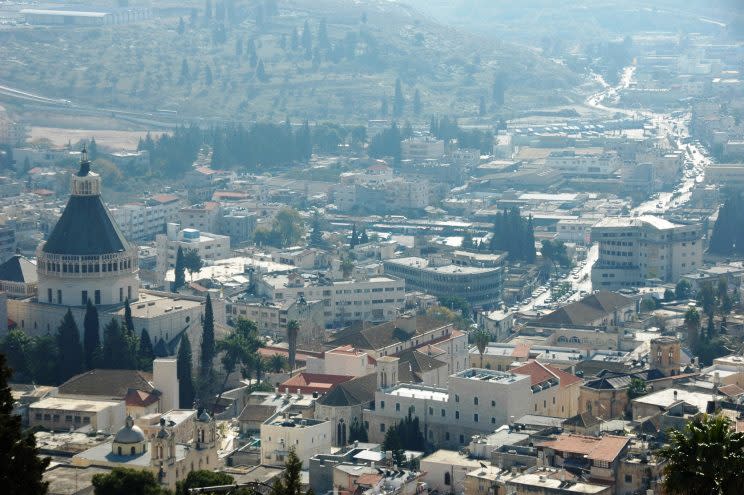
Where Jesus went to school
From the Heights we drive down a steep series of tight turns, then along a fenced-off no-man’s land separating Israel from Jordan, before heading inland towards Nazareth, hometown of Jesus and Mary, and the country’s unofficial ‘Arab capital’.
There are actually two cities of Nazareth now. The first is predominantly Arab and positively teeming with life. Shops, churches, cars and kids all compete for space amid narrow alleys and packed streets. A few kilometres away though seemingly apart of another century, is the Jewish Nazareth, a modern, rapidly growing city of condo towers and shopping malls. Here the roads are wide, the sidewalks empty and immaculate.
As sparkling and manicured as the new and improved version is, it’s the other Nazareth, of course, that draws the crowds. That’s the one featured in the Bible. It’s there where God is said to have sent the angel Gabriel down to tell Mary that she would have a son whose ‘kingdom will never end.’
Yet nailing down exactly where this conversation took place is no small matter. Just as the Church of the Holy Sepulchre hosts rival shrines marking the same event, so too does downtown Nazareth. The biggest and most imposing, is the Catholic basilica, featuring a wall-to-wall gallery of Marian works of art (or devotions) from around the world. (Sadly, Canada’s modest wooden offering is among the least impressive).
Just up the street from the basilica is the Greek Orthodox version, which is much older, considerably smaller and far less arty. The distinctive element here is an underground spring inside the apse. In the Greek Orthodox telling of the ‘annunciation’, Gabriel approached Mary when she was drawing water from a well, which today stands just outside the church.

Between these two landmarks is where Nazareth’s biggest non-biblical attraction sits. Divided into separate sections – bridal gowns here, carpets there, grilled meats just beyond – the city’s main souk is steeped in Mid-East tradition. Save for the clothing styles and tech gadgetry, it’s surely not that different from the scene that would have existed when Jesus ran these streets. Indeed the sense of history interwoven with the incredibly rich hospitality shown by the Arab merchants lent the market an otherworldly aura.
(Of course, having a Bedouin guide who seems to know every shopkeeper only enhances the experience, although Abdullah insists the warmth displayed would extend to anyone, including Nazareth’s Jewish community, a great many of whom were clearly enjoying the same street scene as us.)
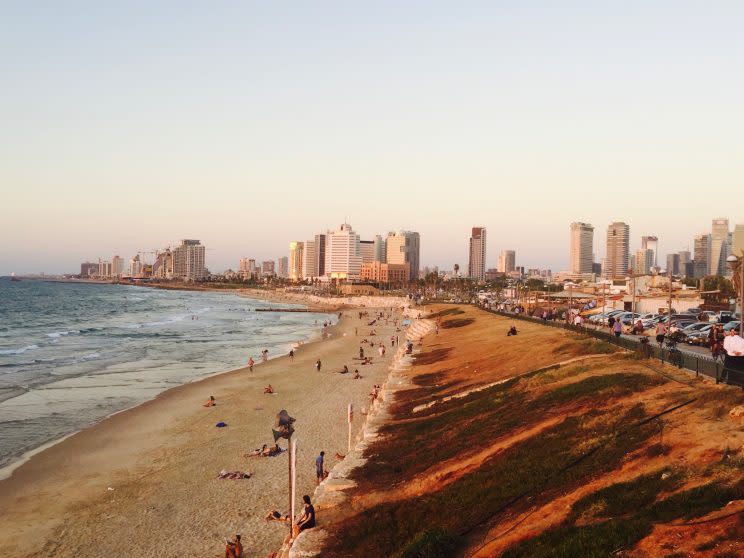
Miami on the Mediterranean
Leaving Nazareth, my last stop is Tel Aviv, Israel’s financial centre and quite clearly the country’s party capital. Though billed as ‘The City that Never Sleeps’, its café-lined streets and stunning seafront makes Tel Aviv feel much more like
South Beach than New York. In fact there are so many people sitting out on sidewalk terraces that I wonder if anyone actually works here.
Whatever religious sentiments animate the rest of the country they’re clearly an afterthought here, exerting much less of a gravitational pull than the gorgeous beachside promenade that runs the length of the downtown, and the innumerable patios and pubs overflowing with beautiful locals.
If Jerusalem is a one-of-a-kind biblical wonderland, deeply wedded to the past, Tel Aviv is an ardently modern Mediterranean city, with its own distinctive style. This is Bauhaus central. And that’s not just expressed with an iconic building here or there. No, essentially the whole downtown pays homage to the International, or Bauhaus, school of architecture. This is so much so that Tel Aviv – the entire city – is now a World Cultural Heritage Site. It’s even given rise to a competitive motto: “The White City”, in reference to the movement’s preference for modernist, white, unfettered design.
The result is a frankly stunning inner city with an incredible sense of place. It’s been shaped by a clear vision – compact, pedestrian-friendly and livable – yet with a free enough hand to allow creativity and surprise. That’s evident in the coffee kiosks and tiny playgrounds that thrive quite literally in the middle major boulevards. It’s also shown in the public art, official and otherwise, that enriches so many corners and crannies here.

If there is a unifying faith in Tel Aviv, aside from the worship of beautiful bodies and fabulous beaches, it’s in the redemptive powers of retail. Streets densely packed with chichi boutiques and hair salons converge inwards towards the Dizengoff Center, anchoring the downtown.
It’s at the entrances to this mega-mall where the city’s other reality emerges, the one that seems unfathomable to a visitor, yet hovers always near the surface. Armed guards with metal-detecting wands frisk everyone entering. Jackets, bags, pockets, nothing escapes inspection. And on the patios outside, off-duty soldiers in jeans and T-shirts sip coffee with machine guns slung over their shoulders.
Indeed, the sight of guns casually worn, even in the presence of children, is so commonplace that it soon blends into the streetscape, an entirely unremarkable sight. That seems especially true when none of weapons are intended for you. It’s for that other, inconvenient part of life here, that’s always somewhere in the picture.
There’s beauty and art, and all of the warmth that comes with living along the Mediterranean, but unquestioned calm is not part of the package.
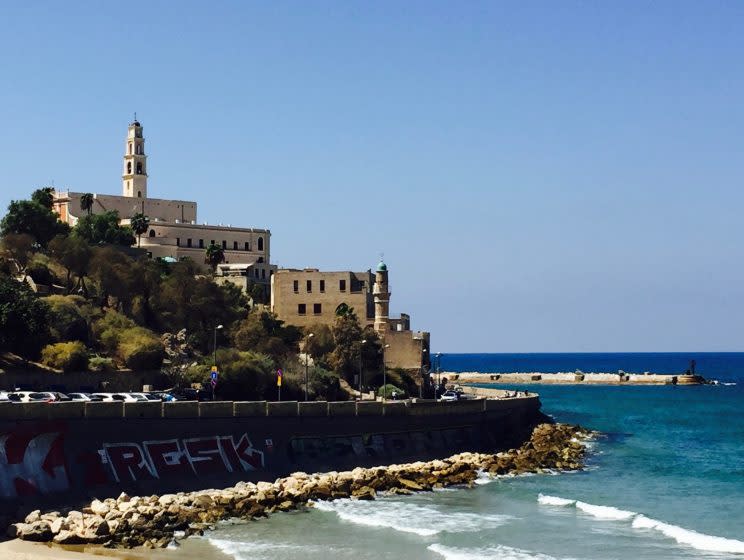
My last hours in Israel are spent in Jaffa, the port from which so much began. For 7,000 years, this country has been continually reshaped by what’s come and gone from these shores. This was the last land Jonah saw before he was thrown overboard and swallowed by the whale, only to pray his way out, back to Jaffa and into biblical legend. This is the harbour that first welcomed the early Zionists, and the refugees of Europe, giving shape to the Israel that exists today.
This is a country that’s more exotic and interesting, colourful and clamorous than imaginable. Its wonders are not only in its natural beauty, which amazes in almost every direction, but also in its history. A history everyone appreciates is both deeply rooted yet anything but settled. Yet it’s not until you’re here that you realize how intimately interconnected everything is, culturally and physically. Like my Dead Sea adventure at the start of this story, neither lengthy descriptions nor stunning photos can ever do this country justice. Israel needs to be experienced, soaked in. Only then can the enchantment of this amazing place be known.

Do no evil
Concerns around security are natural enough when visiting Israel. The news Canadians get of the country is almost invariably focused on conflict, whether it’s tensions around the new settlements or a random stabbing in the street. Such events, of course, capture only an extraordinarily slim glimpse of the country, and not something that shapes the lives of most Israelis, much less tourists.
One place in Israel where you most emphatically don’t need to worry about security is at the airport. Ben Gurion International, just southeast of Tel Aviv, has so many layers of control that I began to lose track after the fourth of fifth checkpoint.

It starts at the perimeter of the airport grounds, miles from the main terminal. Soldiers stop all incoming cars for an inspection that can take minutes or hours, depending on what they deem appropriate. At the entrance to the terminal, another phalanx of soldiers await, sizing up all travelers who pass through. Next is an interview with a security agent who will grill you on the nature of your visit, focusing on where you’ve been and whom you were with. Then comes the standard security process with the metal detectors, hand wands and pat downs. That step is followed by a biometric scanner of your passport and eyes; the results of which have to be entered into, or checked against, a database before you can proceed. Lastly, just as you exit the departure lounge to walk down the ramp you will be met again by the agent who first cleared you for travel, lest somehow someone swapped places with you.
Know too, that when the plane finally takes off, there will be undercover air marshals on board, armed and ready to intervene if anything suspicious emerges.

 Yahoo Finance
Yahoo Finance 
